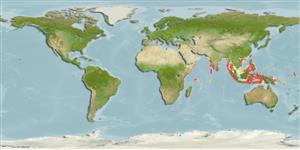Classification / Names
Common names from other countries
Main reference
Size / Weight / Age
Max length : 23.0 cm TL male/unsexed; (Ref. 244); 24.0 cm TL (female)
Length at first maturity
Lm ?, range 15 - 16 cm
Environment
Marine; bathydemersal; depth range 71 - 766 m (Ref. 10004)
Climate / Range
Deep-water, preferred ?; 22°N - 10°S
Distribution
Indo-West Pacific: widely distributed but with spotty records from Tanzania, the Gulf of Aden, India (Gulf of Mannar, Bay of Bengal), Andaman Islands, Viet Nam, and the Philippines. The immense range of this species is striking compared to the limited ranges of other members of the genus.
Countries | FAO areas | Ecosystems | Occurrences | Introductions
Short description
Dorsal
spines
(total): 0;
Dorsal
soft rays
(total): 0;
Anal
spines: 0;
Anal
soft rays: 0. Caudal fin without a rippled dorsal margin and ventral lobe but with a strong subterminal notch; vertebral axis of caudal fin little raised above body axis (Ref. 13566). Dark brown with blackish markings on dorsal fins (Ref. 13566).
IUCN Red List Status (Ref. 115185)
Human uses
More information
ReferencesAquacultureAquaculture profileStrainsGeneticsAllele frequenciesHeritabilityDiseasesProcessingMass conversion
Tools
Special reports
Download XML
Internet sources
Estimates of some properties based on models
Phylogenetic diversity index
PD50 = 0.6328 many relatives (e.g. carps) 0.5 - 2.0 few relatives (e.g. lungfishes)
Trophic Level
4.1 ±0.3 se; Based on diet studies.
Resilience
Very Low, minimum population doubling time more than 14 years (Fec=1)
Vulnerability
Low vulnerability (13 of 100)
Price category
